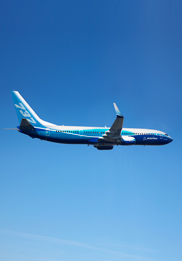

|
Global airspace and airline operations are moving to performance-based navigation (PBN), which provides a basis for designing and implementing automated flight paths that will facilitate airspace design, traffic flow, and improved access to runways. This change offers a number of operational benefits, including enhanced safety, increased efficiency, reduced carbon footprint, and reduced costs. To fully realize these benefits, operators may need to make changes to their airplanes and operations. |
| PERFORMANCE-BASED NAVIGATION WILL ENABLE EFFICIENCY-ENHANCING OPERATIONS IN THE FUTURE. | By David Nakamura, Senior Technical Fellow, Airplane Systems; and William Royce, Chief Pilot — Research, Flight Operations |
Operators have already begun to experience the benefits of area navigation (RNAV) and required navigation performance (RNP). These benefits include safer, more efficient operations; greater capacity; and improved access. For instance, freeing airplanes from reliance on ground-based navigational aids (navaids) and allowing flexible and optimum routing with satellite navigation can create more direct routes, saving fuel and reducing CO2 emissions and enroute flight time.
However, the definitions and concepts associated with RNAV and RNP, as well as some RNP naming conventions, are inconsistent both in the United States and in various regions of the world. The result has been confusion among operators, manufacturers, regulators, and air navigation service providers (such as the U.S. Federal Aviation Administration [FAA], United Kingdom National Air Traffic Services [NATS], and NavCanada) in the implementation of RNAV and RNP applications in different areas in the world.
PBN is the result of recent collaboration between industry, states, regulators, and service providers to understand the issues leading to this confusion, and to clarify and update the definitions and explanatory material about RNAV and RNP concepts and applications. To ensure harmonization and consistency, this effort was applied to all areas of flight, from oceanic/remote to terminal area and approach.
This article provides background about RNAV and RNP, reasons for the move to PBN, benefits of PBN, the industry’s PBN strategy, and keys for airlines to move successfully to PBN.

